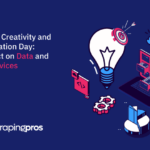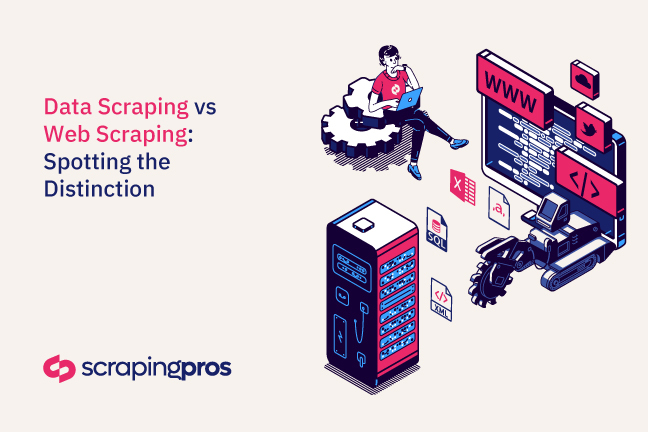In this post we will discover the differences and similarities between the terms Data Scraping and Web Scraping, and some use cases, understanding that – despite the different terminology – both are part of the same technical and business process.
Today’s companies and organizations increasingly depend on strategic information to make crucial decisions in the era of big data. Collecting data can be difficult and time-consuming, which is why many companies use automated techniques such as data scraping and web scraping.
Knowing both terminologies in the industry is important. Beyond the current debates, it is important to understand that both (data & web) are part of the same process that understands data extraction as a value in itself and a way of structuring that data to make increasingly efficient decisions. Confusion or misunderstandings in terminology are common among practitioners or early adopters of the technology: however, the difference lies more than anything in the description that is made of both terms and the fact that Web Scraping involves pure data extraction and exclusively on the public website.
In this sense, data is the new treasure of business in the 21st century. Therefore, there are more and more processes based on information such as price comparison, market studies, consumer feedback, and brand monitoring, which provide valuable insights to make better decisions. Let us now explore both terminologies and their frequent uses.
What is Data Scraping?
The definition of data scraping, often mixed with web scraping, is when you take publicly available data, whether on the web or your computer and import the information found into any local files on your computer. Sometimes this data may also be funneled to another website. This data mining is one of the most effective ways to get data from the web and does not require an internet connection. One of the main differences is that traditional data extraction, which is not applied to websites, usually uses structured data sources such as databases or spreadsheets. However, it is not an exclusive practice since data scraping can involve any type of data source.
What is Web Scraping?
Web scraping occurs when publicly available online data is taken and the information found is imported into any local file on your computer. The main difference here with data scraping is that the definition of web scraping requires that it be done over the Internet. It is also usually done through a scraper, infrastructure, or data extraction service provider.
Uses of Data Scraping and Web Scraping
Some possible uses of data scraping in the business field are automated businesses, Developing personalized market studies, Lead generation and scoring of potential customers, Price tracking (dynamic), and Brand monitoring.
To refine these processes, it is advisable to hire a more specialized service and it is recommended that you focus on Web Scraping to take advantage, above all, of data from competing websites and your data from clients and the product or service that we market.
In this case, it is about identifying, extracting, and delivering high-quality real-time data in the client’s preferred format, ensuring it is ready for immediate integration into your database or upload queue.
Beyond this, whether we are referring to Data Scaping or Web Scraping, different problems appear to be overcome in your specific application.
Legal implications
Before extracting data from online sources, we must understand the legal implications. The legal consequences of data scraping and web scraping may differ minimally.
Data scraping is often done with the permission of the data owner or provider. If the data being extracted is copyrighted or protected by intellectual property laws, approval may be required to use it. However, if the data is public or falls within fair use guidelines, permission may not be required.
Web scraping, on the other hand, can be a legal challenge. Some websites prohibit web scraping in their terms of service, and web scraping can potentially violate copyright laws. As a result, it is essential to understand the legal implications of web scraping before using it.
It should be noted that beyond these implications, web scraping is currently regulated by compliance principles in some parts of the world. Current jurisprudence, both in the United States (Ninth Circuit of Appeals, 2022), Europe (PSD2 standard), and Australia (Recommendation number 22 of the Senate Committee on Financial Technology and Technology Regulation) favors the use of web scraping.
Technical challenges
The main technical challenges of using these massive data extraction and collection methods have to do with the dynamics of the data, its frequent updating, accessibility and scalability.
- Data Dynamics: Both databases and public websites undergo regular structural changes to improve design and functions, leading to better user experience. However, such changes can significantly complicate the data scraping process. In the case of Web Scraping, when monitoring public data in real-time, many things can change in just a day, if not hours. With thousands of target websites on the Internet, businesses must constantly update the data they use in real-time and at scale. For business decisions, data accuracy is paramount. And this doesn’t always happen, even in the best business practices. Web crawlers need to simulate user interactions, handle asynchronous requests, and extract public data from dynamically generated content.
- Updating: The data one acquires must be recent and relevant to the current period to be of any use. If the sources that are chosen have old and outdated data available, the business analysis is being put at risk by obtaining irrelevant results that do not fit the current period. Something much more crucial in the case of Web Scraping: you should always look for websites that are regularly updated with new and relevant data to include as scraping sources. If the dates are not displayed on the site, you can always drill down into the source code to find the last modified date of the HTML document.
- Accessibility: It is important to avoid sites that discourage bots, although it is technically feasible to track and extract data from sites that block automated bots through IP blocking or similar technologies, it is not recommended to include such websites in the general list. In addition to the associated legal risk, a site that discourages automated scraping runs the risk of losing data when this site implements better-blocking mechanisms in the future. At the same time, we should not choose sites with too many broken links. A website with too many broken links is a poor choice as a source of web scraping (a clear indicator of negligence from the website administrator). A web scraping setup will also stop when it finds a broken link.
- Scalability: To stay competitive, through price optimization or market analysis, companies must collect large amounts of public data on customers and competitors from different sources and do so quickly. For small businesses, creating a highly scalable web scraping infrastructure is quite unrealistic due to the immense time, effort, and software and hardware expenses required.
Use cases and main benefits
As we have pointed out, Data Scraping is a process through which an application extracts information from the output generated by other software. In the specific case of the Web, Scraping consists of taking data from the pages of an Internet website, classifying it according to its characteristics, dividing it into categories, and storing it in a database.
Scraping allows you to extract data from the output of applications and web pages through automated tools and processes. Its role in data analysis takes on an increasingly important role as it allows access to valuable information for digital marketing, SEO, pricing strategies, data-driven business processes, and business decisions.
The main real-world use cases where both Data Scraping and Web Scraping applications are integrated would be:
- Retail: Data Scraping is usually associated with the organization of data in traditional physical stores of mass consumption products, while Web Scraping with the extraction and organization of digital data of products that are beginning to be marketed through different platforms. or websites. However, in terms of Retail, it is part of the same unified process that understands the business as a whole and entails enormous new challenges in the face of competition, such as comparison and dynamic pricing.
- Health/Pharmacovigilance: Web data mining techniques that capture data from patient posts and social media users can process new information on adverse effects derived from the administration of medications and also new demands for health services. These techniques are providing fundamental support for industry decision-making and here digital transformation, and not just data, is a key aspect.
- E-Commerce/Digital Marketing: Data-driven marketing and Web Scraping open countless unimaginable opportunities to make informed decisions and lead marketing strategies in all aspects of a business. Data-driven marketing takes into account large amounts of information about all business processes, primarily about consumers. Today, marketers spend more than $6 billion a year to create solutions using data management platforms and demand-side platforms to get their message to users.
- Finance/Fintech: Using Scraping for financial data analysis is crucial for more accurate market data analysis and stock trading as it automates data extraction for better decision-making, providing a return of optimal investment. This process deepens when there is greater growth and scalability of data from the proliferation of companies called “fintech”, neither more nor less those companies that seek to offer financial solutions using new technologies focused on users.
- Media and News (data journalism): Today web data is generating a revolution in the way of creating and telling stories. The sources from which data can be extracted, which are practically unlimited, allow us to interpret and visualize a heterogeneity of data aimed at explaining an existing news story or finding a story, not obvious, within the data. The momentum of web scraping technologies for data journalism is enormous for telling better stories, finding hidden patterns in information, and detecting trends of interest in the audience.
- Information technologies: The Telecommunications & IT sector is experiencing a moment of expansion due to the Industry 4.0 phenomenon: the application of new technologies in the value chain allows it to increase its productivity, reduce costs, improve its processes, and access information in real-time. In this context, not only Big Data and Cloud Computing play an essential role, but also the concept is known as the “Internet of Things”, a network of physical objects such as sensors and devices capable of connecting and exchanging data between Yeah.
Reviewing the debate. Conclusions
Despite all the challenges and problems mentioned, and the subtle differences in terminology, Data Scraping and Web Scraping are practically two sides of the same coin. On the one hand, they present broad benefits for use in different types of businesses and use cases, and on the other hand, companies continue to find new and innovative ways to collect the data they need. Regardless of whether this process is called “Data Scraping, Web Scraping” or simply “data extraction or data mining”, the idea always remains to add value to the information hidden in databases, software, and public Internet sites, considering that data products have been digitized and are part of the ecosystem of online platforms.
Without a doubt, Scraping has become a vital technological solution in the data-driven era, fostering innovation across industries. Its ability to extract and analyze large amounts of data allows companies, researchers, and individuals to make informed decisions, identify trends, and drive innovation. As technology continues to evolve, data & web scraping will play a central role in unlocking the power of data and shaping the future of various industries. All this reaching a record market for the coming years, according to predictions and future trends.
We believe that we have settled a debate where the terms Data Scraping and Web Scraping are not antagonistic, but rather different ways of describing or categorizing the same technical process, with excellent benefits and opportunities, if our client knows how to take advantage of and exploit them.






